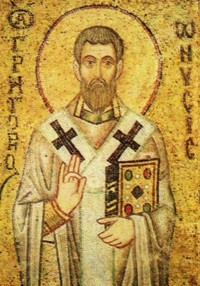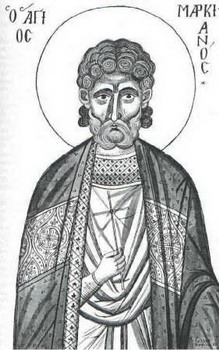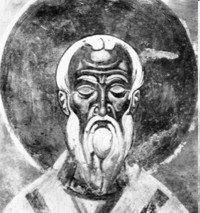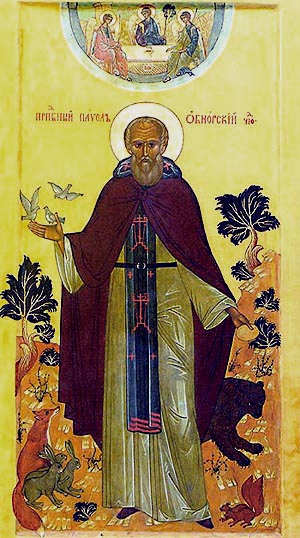|
|
St Gregory, Bishop of Nyssa The brother of St Basil the Great, he was at first a married priest, but when his wife, the blessed Theosevia, died, he was chosen and consecrated as Bishop of Nyssa. He was distinguished by great secular learning and spiritual experience, and was a great preacher, a translator of the Scriptures and a theologian. As a result of his opposition to the Arians, they did everything in their power to crush him, regarding him as their chief enemy. They were so successful in this that, in the reign of the Emperor Valens, their confederate, they managed to depose him from his episcopal seat and drive him into exile. This was in 376. The holy Father spent several years in patient exile, enduring poverty and humiliation. In 381, he took part in the Second Ecumenical Council, and it is thought that he formulated the final part of the Creed concerning the Holy Spirit. Finally, finishing his life at a great age in about the year 395, he entered into the Kingdom of God and has been commemorated through all succeeding ages as a great light in the Church. The brother of St Basil the Great, he was at first a married priest, but when his wife, the blessed Theosevia, died, he was chosen and consecrated as Bishop of Nyssa. He was distinguished by great secular learning and spiritual experience, and was a great preacher, a translator of the Scriptures and a theologian. As a result of his opposition to the Arians, they did everything in their power to crush him, regarding him as their chief enemy. They were so successful in this that, in the reign of the Emperor Valens, their confederate, they managed to depose him from his episcopal seat and drive him into exile. This was in 376. The holy Father spent several years in patient exile, enduring poverty and humiliation. In 381, he took part in the Second Ecumenical Council, and it is thought that he formulated the final part of the Creed concerning the Holy Spirit. Finally, finishing his life at a great age in about the year 395, he entered into the Kingdom of God and has been commemorated through all succeeding ages as a great light in the Church.Our Holy Father Ammon of EgyptHe was an Egyptian ascetic. At the age of fourteen, he strove and prayed to God to kill all anger in him. He achieved such perfection of goodness that he was no longer aware of the existence of evil in the world. He was an outstanding expert in the Scriptures, and entered into rest at the beginning of the fifth century.
St Marcian He was born in Rome, but lived as a priest in Constantinople to the end of his life, during the greater part of the reign of Marcian and Pulcheria. The inheritor of great wealth from his parents, he spent it unstintingly on two objects: the building or restoring of churches, and charity to the poor. He built two new churches in Constantinople, dedicated to St Anastasia and St Irene and famed as beautiful and holy places. When asked why he spent so much of his wealth on churches, he re lied- "If I had a daughter and was-giving her in marriage to some nobleman, would I not expend much gold to adorn her as a worthy bride? Here, I am adorning the Church, the Bride of Christ." This great man, while being so generous to the churches and the poor, was very hard towards himself, following the evangelical counsel: "Having food and raiment, let us therewith be content" (I Tim. 6:8). It was written of him: "He was utterly in God and God in him", and he went to God, full of years and good works, in the year 471. He was born in Rome, but lived as a priest in Constantinople to the end of his life, during the greater part of the reign of Marcian and Pulcheria. The inheritor of great wealth from his parents, he spent it unstintingly on two objects: the building or restoring of churches, and charity to the poor. He built two new churches in Constantinople, dedicated to St Anastasia and St Irene and famed as beautiful and holy places. When asked why he spent so much of his wealth on churches, he re lied- "If I had a daughter and was-giving her in marriage to some nobleman, would I not expend much gold to adorn her as a worthy bride? Here, I am adorning the Church, the Bride of Christ." This great man, while being so generous to the churches and the poor, was very hard towards himself, following the evangelical counsel: "Having food and raiment, let us therewith be content" (I Tim. 6:8). It was written of him: "He was utterly in God and God in him", and he went to God, full of years and good works, in the year 471.Venerable Dometian, bishop of Melitene The Monk Dometian, Bishop of Meletineia, was born and lived during the VI Century, during the time of the emperor Justin the Younger. He was married but early on widowed, thereafter accepting monasticism and living a strict and holy life. At thirty years of age he was chosen bishop of the city of Meletineia (Great Armenia). Wise and zealous in questions of faith, strong in word and deed, Saint Dometian quickly gained fame as a good and ardent pastor. More than once he carried out government commissions in Persia to avoid conflicts with the Greeks. Beloved by everyone, the Monk Dometian often received rich gifts, which he distributed for the welfare of the poor. Both during his lifetime and after his death, occurring in the year 601, Saint Dometian was glorified by God with miracles. The Monk Dometian, Bishop of Meletineia, was born and lived during the VI Century, during the time of the emperor Justin the Younger. He was married but early on widowed, thereafter accepting monasticism and living a strict and holy life. At thirty years of age he was chosen bishop of the city of Meletineia (Great Armenia). Wise and zealous in questions of faith, strong in word and deed, Saint Dometian quickly gained fame as a good and ardent pastor. More than once he carried out government commissions in Persia to avoid conflicts with the Greeks. Beloved by everyone, the Monk Dometian often received rich gifts, which he distributed for the welfare of the poor. Both during his lifetime and after his death, occurring in the year 601, Saint Dometian was glorified by God with miracles.St. Theophan the Recluse, bishop of TambovVenerable Paul of Komel'sk The Monk Paul of Komel'sk, a famed student of the Monk Sergei of Radonezh, was born at Moscow in the year 1317. From his youthful years he distinguished himself by his piety and kindliness towards the poor and suffering. His rich parents prepared him for a secular life, but at twenty-two years of age he secretly left his parental home and received tonsure at the Nativity monastery on the Volga (in Yaroslavsk diocese).
From there Paul transferred to the Holy Trinity monastery to the Monk Sergei of Radonezh, spending several years with him as a cell-obedient, in everything obeying the wise guidance of the holy starets (elder). With the blessing of the Monk Sergei, he settled a way off from the monastery in a separate cell, where he spent fifteen years as an hermit. Having asked the blessing of the Monk Sergei to go off into the wilderness for a quiet and solitary life, the Monk Paul wandered about for a long while, seeking for himself the place of solitude. He went much about the wilderness, he spent time with the Monk Avraamii of Chukhlomsk (Comm. 20 July) and finally, he remained in the Komel'sk forest. At the Gryazovitsa River, in the hollow of an old linden tree, the monk made himself a small cell and dwelt there for three years in complete silence, "not giving his body rest, for which to receive future rest". Then he moved on to the River Nurma, where he built himself an hut and dug out a well. He spent his days in vigil and prayer. Five days out of the week he went without food, and only on Saturday and Sunday did he partake of some bread and water. The news spread widely about the hermit, and there begin coming to him those wishing spiritual guidance of him. Despite his love for the solitary life, the Monk Paul never refused anyone in spiritual consolation and guidance. He was visited here also by the Monk Sergei of Nuromsk, who likewise had sought solitude with the blessing of their teacher the Monk Sergei of Radonezh, and who likewise passed his ascetic life in these locales.
With the blessing of the Monk Sergei and the agreement of Metropolitan Photii, the Monk Paul in 1414 built the Holy Trinity Church, around which grew up a monastery, receiving the name of Pavlo-Obnorsk. Having written for the brethren a strict ustav (monastic rule), the Monk Paul entrusted the guidance of the new monastery to his disciple Aleksei, while he himself continued as before to live in a solitary cell on an hill, meanwhile remaining a responsive and good counsellor for anyone needing his healing help. The Monk Paul died at 112 years of age. His final words were: "Brethren, have love one for another and keep to the rule of the monastic community".
The Life of the saint was written in about the year 1546, and his glorification occurred in 1547. The Monk Paul of Komel'sk, a famed student of the Monk Sergei of Radonezh, was born at Moscow in the year 1317. From his youthful years he distinguished himself by his piety and kindliness towards the poor and suffering. His rich parents prepared him for a secular life, but at twenty-two years of age he secretly left his parental home and received tonsure at the Nativity monastery on the Volga (in Yaroslavsk diocese).
From there Paul transferred to the Holy Trinity monastery to the Monk Sergei of Radonezh, spending several years with him as a cell-obedient, in everything obeying the wise guidance of the holy starets (elder). With the blessing of the Monk Sergei, he settled a way off from the monastery in a separate cell, where he spent fifteen years as an hermit. Having asked the blessing of the Monk Sergei to go off into the wilderness for a quiet and solitary life, the Monk Paul wandered about for a long while, seeking for himself the place of solitude. He went much about the wilderness, he spent time with the Monk Avraamii of Chukhlomsk (Comm. 20 July) and finally, he remained in the Komel'sk forest. At the Gryazovitsa River, in the hollow of an old linden tree, the monk made himself a small cell and dwelt there for three years in complete silence, "not giving his body rest, for which to receive future rest". Then he moved on to the River Nurma, where he built himself an hut and dug out a well. He spent his days in vigil and prayer. Five days out of the week he went without food, and only on Saturday and Sunday did he partake of some bread and water. The news spread widely about the hermit, and there begin coming to him those wishing spiritual guidance of him. Despite his love for the solitary life, the Monk Paul never refused anyone in spiritual consolation and guidance. He was visited here also by the Monk Sergei of Nuromsk, who likewise had sought solitude with the blessing of their teacher the Monk Sergei of Radonezh, and who likewise passed his ascetic life in these locales.
With the blessing of the Monk Sergei and the agreement of Metropolitan Photii, the Monk Paul in 1414 built the Holy Trinity Church, around which grew up a monastery, receiving the name of Pavlo-Obnorsk. Having written for the brethren a strict ustav (monastic rule), the Monk Paul entrusted the guidance of the new monastery to his disciple Aleksei, while he himself continued as before to live in a solitary cell on an hill, meanwhile remaining a responsive and good counsellor for anyone needing his healing help. The Monk Paul died at 112 years of age. His final words were: "Brethren, have love one for another and keep to the rule of the monastic community".
The Life of the saint was written in about the year 1546, and his glorification occurred in 1547. Blessed Theosebia the DeaconessBlessed Theozua the Deaconess was the sister by birth of Saints Basil the Great, Gregory of Nyssa, and Paul, Bishop of Sebasteia. She was a virgin and served Holy Church as a deaconess, caring for the sick, distributing food to vagrants, raising orphans and preparing women for holy Baptism. When her brother, Saint Gregory of Nyssa, was in exile for three years, Saint Theozua was with him and she shared in all the tribulations of a life of wandering. Saint Theozua died in the year 385, and Sainted Gregory the Theologian honoured her memory in an eulogy.
|